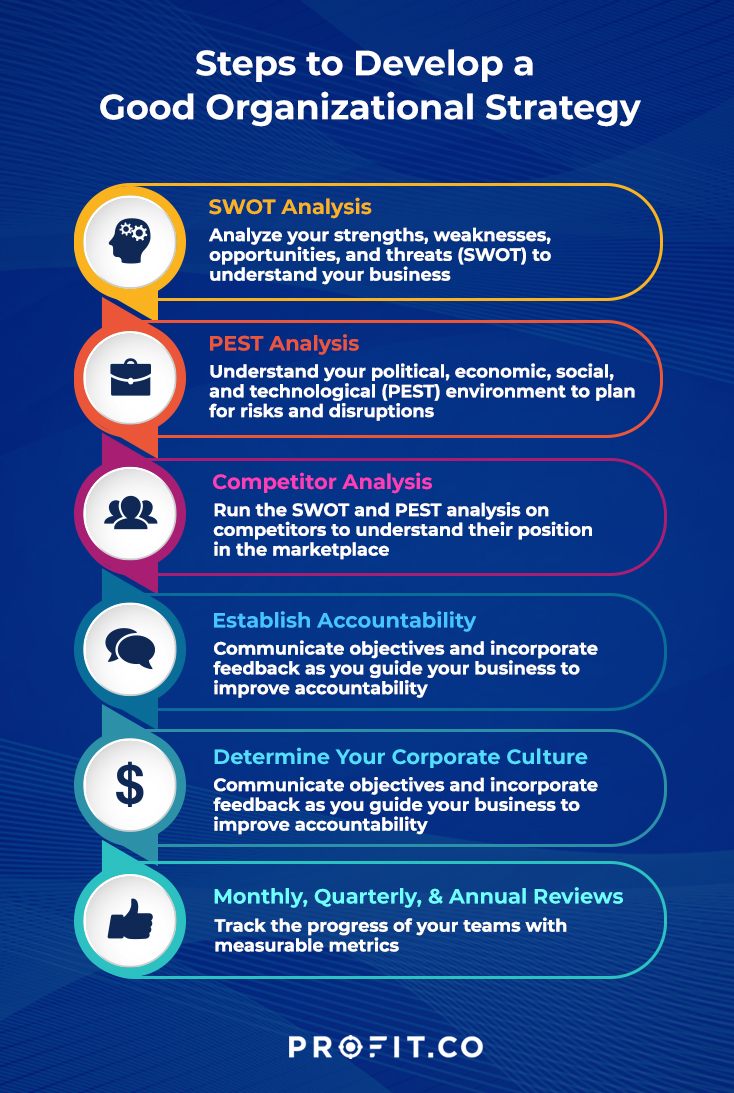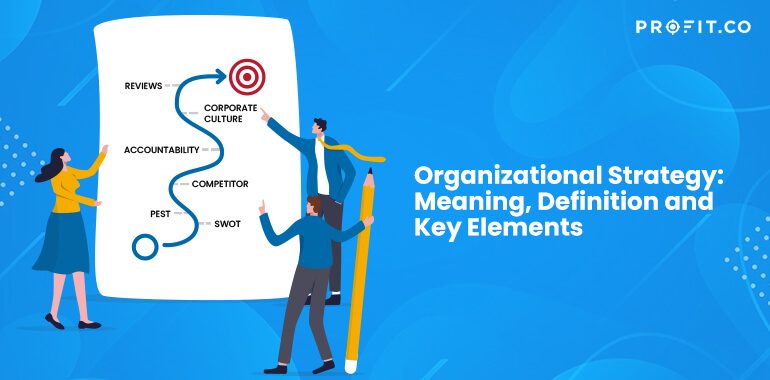Introduction
Organizational strategy is essential in all successful businesses, regardless of size or industry. An excellent organizational strategy improves how you set goals, motivate your team, and remain relevant in the marketplace. This guide explains the different organizational strategies and how to build the proper framework for your business today.
What Is an Organizational Strategy?
An organizational strategy is a roadmap for how a business uses its resources over the short and long term. Resources include capital, talent, inventory, and premises, all of which help a company achieve its vision and mission.
An organizational strategy affects
- Employee performance
- Customer satisfaction
- Product Quality
- Company culture
- Competitive advantage
What Organizational Strategy Is NOT
Many entrepreneurs assume they already have an organizational strategy, which is often a mistake. Here’s why:
1. A Goal Is Not an organizational Strategy
A strategy explains how you’ll achieve your goals by making choices that benefit your business. In other words, it is a path toward your goals.
2. An organizational Strategy Is Not Your Status Quo
An organizational strategy takes time, thought, and human resources to develop. But some businesses take the shortcut and write their existing way of doing business as their strategy. It’s easy to add “strategy management” to any statement without making any difference in your operations.
3. An organizational Strategy Isn’t a C-Suite Secret
A business may have the best strategic organizational plan, but if middle and lower-level managers don’t know it, it does nothing for the company. An organization’s strategy needs everyone’s awareness and input to influence their everyday work and behavior.
Why Do You Need an Organizational Strategy?
Every business needs an organizational strategy to gain the benefits outlined below:
1. A Sense of Direction
A strategic organization plan outlines a consistent business direction, so everyone knows what they’re working towards. It also prioritizes business activities to move your company forward. Without strategy management, you burn precious resources on actions that do little for your vision and growth.
2. A Common Goal
Organizational strategy gives every team member a clear goal contributing to business success. For example, suppose your organization’s strategy prioritizes good customer service. In that case, everyone from the C-suite down knows the value of every client at every interaction.
3. Better Decision-Making
A transparent organizational strategy helps you navigate tough business decisions, such as recruitment, training, diversifying your products, digital transformation, and more. Use your strategic organizational plan as a reference point to guide your choices for business growth.
4. Better Change Management
Many unexpected challenges arise in every business, from economic disruptions to cutting-edge innovations. With the right organizational strategy, companies can navigate these changes and adapt to stay relevant in their industry. Strategy & organization keeps you motivated to move forward instead of giving up on your business.
Strategy without tactics is the slowest route to victory. Tactics without strategy is the noise before defeat
What are the Categories of Organizational Strategy?
An organizational strategy has three key categories:
- Corporate
- Business
- Functional
This category is complex and broad since it carries your overall company goals. Corporate strategies include diversification, liquidation, growth, differentiation, or low-cost production.
This category breaks down corporate strategies into departmental goals. For example, a profit-driven corporate strategy can incorporate sales upskilling and increase their marketing budget as business strategies.
This category further breaks down the business strategies into actionable objectives for your team. For example, suppose your business strategy is to conduct market research. In that case, one functional strategy would involve developing the selection criteria for outsourcing a market research company.
Note: These strategy organization categories define your business from a high level to the everyday operations that contribute to your success. Encourage every stakeholder to give feedback about your organizational strategy in each category.

What Are the Qualities of An Organizational Strategy?
Every organization’s strategy should have the following qualities:
- Easily Measurable
- Specific
- Realistic
- Closed-Ended
Your strategy needs trackable metrics to ensure its feasibility. Apply figures like dollar amounts or percentages to your qualitative goals to measure your performance. For example, say you want to increase your revenue by 30% every quarter.
A successful organizational strategy outlines the precise ways to achieve business goals. A vague strategy management approach leads to confusion and wasted resources. Instead, state your plan as clearly as possible. Use figures in your strategy as well, such as to achieve 80% customer satisfaction.
Understanding your business thoroughly creates a realistic organizational strategy. Of course, ambition is always welcome, but keep it within the available company resources. Break down your plan into achievable goals instead of overwhelming your team with unattainable targets.
Limit your strategy & organization to deadlines and targets instead of leaving it open-ended. Each goal should have a time limit of months or years to give your team a tangible guideline, including how to cope with contingencies.
How To Develop A Good Organizational Strategy
The following steps can help business leaders to create a successful organizational strategy:
Step 1: SWOT Analysis
Analyze your strengths, weaknesses, opportunities, and strengths (SWOT) to understand your business. When you’re honest about your abilities, you accurately assess your company and identify challenges in advance.
Step 2: PEST Analysis
Analyze your external business conditions to understand your political, economic, social, and technological (PEST) environment. This analysis helps your business to plan for risks and disruptions that may threaten your success.
Step 3: Competitor Analysis
You can also run the same SWOT and PEST analysis on your competitors to understand their position in the marketplace. Use your strategic management skills to convert their weaknesses and challenges into strengths to maintain your competitive edge.
Step 4: Establish Accountability
As you create your organization strategy, know which team member is responsible for which goals or tasks. Communicate your objectives and incorporate feedback as you guide your business toward strategic success.
Step 5: Determine Your Corporate Culture
Your strategy & organization directly define your company culture. As an example when you want to build a superior tech business, you must choose the right team to achieve this vision. In addition, you must create the right workplace environment to inspire their creativity and offer competitive remuneration to keep them motivated. All these factors go into your organization’s strategy and affect your corporate culture.
Step 6: Monthly, Quarterly, And Annual Reviews
Check regularly that your measurable and specific strategic goals are on target. Involve your entire team in your strategy management reviews to understand your business position.
How To Avoid organizational Strategy Failures
Having your organizational strategy on paper is one thing, but implementing it is the true challenge. Many businesses struggle due to the following reasons:
1. Lack of Alignment and Buy-In from Your Team
If you create your strategy & organization plan on your own, you can expect differences and questions from your team. From the start, it is important to get everyone and encourage their feedback.
2. Lack of A Strategy Implementation Approach
There are five primary methods of tracking and implementing organizational strategy:
- Management by objectives (MBO)
- Cascade method
- Hoshin planning method
- Balanced scorecard approach (BSC)
- Objectives and key results (OKR)
Book a free demo with our team to learn more about how OKR software can optimize your organization’s performance!
Your strategy will likely fail if you don’t follow any of these implementations. It’s better to choose a tried-and-tested approach than to wing it and hope for the best.
3. Overestimating Your Abilities
Organizational strategy often overwhelms even the best team members, especially if the goals and targets are beyond their abilities. Understand what you and your team can realistically achieve to avoid strategy failure.
4. Poor Budgeting
An organization’s strategy needs capital to implement. You may need funds to support a refreshed ad campaign, recruit new talent to your team, or buy software subscriptions to streamline your workflows. Add a currency amount to each strategic goal to plan your finances.
5. Poor Time Allocation
Just like budgeting, strategy management takes time to implement. Your strategy will fail if you have no minimum or maximum time limit for each goal or task. Allocate the ideal deadlines and accommodate unforeseen challenges as you implement your strategy.
Organizational Strategy FAQs
1. Why is organizational strategy important?
An organizational strategy defines your day-to-day business functions and workplace culture. It transforms your company mission and vision into a measurable action plan.
2. Should I hire an organizational strategy consultant?
A strategy management consultant can help to assess your business and offer practical strategic recommendations objectively.
3. What is the time period to implement an organizational strategy?
It takes an average of five years to see the benefits of your organizational strategy. However, depending on your company’s size and industry, it can take shorter or longer.
4. What makes a good organizational strategy?
A good organizational strategy will:
- Analyze and diagnose your organization
- Use a guiding policy or approach for implementation
- Define clear, measurable actions that build towards your mission and vision.
Conclusion
An organizational strategy guides your business forward with practical, achievable goals. However, implementing your strategic organizational plan is time-consuming and expensive. Many businesses fail due to poor management and leadership. Successful strategy management involves clear communication, thorough analysis, and realistic goals. With the guidelines above, plus expert advice from an organizational strategy consultant, you can outperform your competitors, improve your business outcomes, and prepare your business for the future. You can also use the successful OKR methodology by implementing agile software in your organization. You can get started on Profit.co completely free today!

